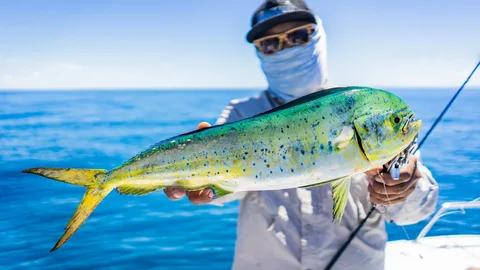Catch Mahi-Mahi, or dolphin: it can be the thrill of a lifetime. With such bright colors and tasty catch, Mahi-Mahi is one of the favorites among anglers as well as sea-food lovers. The diversified coastal regions of the Middle East offer their fair share of chances to hook the coveted fish.
Hence, whether you have experience fishing or just know the ropes, fishing techniques on how to fish Mahi-Mahi can become memorable experiences. Therefore, we will cover the topics to discuss everything about Mahi-Mahi fishing, ranging from techniques, gear, to even some best spots for catching some fish.
About Mahi-Mahi
Before diving into details on how to catch Mahi-Mahi, there is much needed knowledge on the incredible species. Mahi-Mahi is one species of fish identified by brilliant blue, green, and yellow hues. Its colors flash out as the fish swims at its best speeds.
Mahi-Mahi is usually hooked near drifting debris, logs, or buoys because the fish are believed to hold up in close proximity of these structures since they have learned to hide their bodies to avoid predators while searching for food.
They are migratory fishes, which implies that they may be caught in different localities, depending on seasons. Rich flavor and superior quality make them a precious species within seafood markets that increases popularity among fisherman as well.
Gear and Equipment
The right gear assures a great fishing outing. Here’s a breakdown of the most important gear one needs for a Middle East Mahi-Mahi fishing adventure:
Fishing Rod and Reel
A medium to heavy action rod with a good -sized reel is recommended. Look for a rod that stands at about 7 to 8 feet long, offering the necessary casting distance and punch. Your reel should contain at least a 20-to-30-pound catch capacity, as Mahi-Mahi will put up quite a fight.
Fishing Line
A Mahi-Mahi fisherman should have a good line. It is recommended to use braided line of test strength between 30 to 60 pounds and a fluorocarbon leader of about 20 to 30 feet. The leader line will protect you from abrasion caused by the sharp teeth of the fish and offer invisibility underwater.
Hooks and Rigs
Circle hooks should be size 4 to 8. Use multiple rigs including, easy dropper rig or a live bait rig; however, always remember to rig it with at least two hooks.
Tackle Box
Fill your tackle box with pliers, fish gripper, and fishing scissors among other essential tools. This will also comprise artificial lures and bait such as jigs, trolling lures, and soft plastics that are considered effective for Mahi-Mahi.
Bait
Live bait always catches Mahi-Mahi. Some of the common live baits around include small fish species, that is sardines, mackerel, and flying fish. Frozen baits also go well, such as squid and mullet. Lures will include brightly colored ones which can simulate smaller bait fish movement.
Methods for Mahi-Mahi fishing
Trolling
Trolling is one of the most effective techniques to catch Mahi-Mahi. Just drive your boat slowly at about 5 to 8 knots and let your lures or bait trails behind the boat. Pay attention for any sign of Mahi-Mahi in your surroundings such as diving birds or large schools of baitfish.
Drifting
When drift fishing, drift with whatever current is present as you release live bait or lures down into the water. Look for floating debris or birds or jumping fish, which are all signs of feeding Mahi-Mahi.
Cast
You can cast directly into the water when you come across a school of Mahi-Mahi or you notice them hovering over floating structures. Bright shiny lures or live bait attract their attention. Always reel your bait with steady jerking motion to allure them.
Chumming
Chumming is small pieces of bait into the water, and then when the Mahi-Mahi are feeding on it, you can cast your line nearby. This method really works well in attracting a school of Mahi-Mahi.
Best Fishing Places in the Middle East
The Middle East has some prime places to fish for Mahi-Mahi. These are some of the top places to fish:
The Red Sea (Egypt, Saudi Arabia)
It has fresh water and high biodiversity. The closest ports to fish are the coastal towns of Sharm El Sheikh or Hurghada in Egypt, and the port city of Jeddah in Saudi Arabia, so fishermen have a good opportunity to catch Mahi-Mahi next to driftwoods or coral reefs.
Arabian Gulf (Kuwait, Qatar, UAE)
It has a lot of marine resources, and many fishing grounds exist. Some of the waters off Doha, Abu Dhabi, and Kuwait City are actually better for Mahi-Mahi, especially during warmer months.
Oman
The Oman coast is another good place to catch Mahi-Mahi. Places around Muscat, Salalah, and the Musandam Peninsula offer good fishing conditions because of abundant baitfish that attract Mahi-Mahi.
Bahrain
Although a smaller fishing location, Bahrain’s surrounding waters can produce excellent Mahi-Mahi catches, especially near artificial reefs and structures.
Respecting Regulations and Sustainability
When fishing for Mahi-Mahi in the Middle East, one needs to respect local fishing regulations. Get any license one may need and know how much fish to catch, the season, and size of the fish. This way, the fish population will be preserved, and there will be sustainable fishing.
There should be responsible fishing methods and techniques that do not harm other marine life. Catch and release, especially the larger Mahi-Mahi, must also be practiced for healthy fish stocks in the future.
Conclusion
It is always exciting and fun to know how to fish for Mahi-Mahi in the Middle East. Proper gear, techniques, and knowledge of the best fishing spots within this region can make this very vibrant fish come aboard. Respect local fishing regulations and sustainable methods for future generations to enjoy fishing for Mahi-Mahi.
Whether you cast from the boat or the shore, you will expect to have your fight of life if the Mahi-Mahi happens to take your bait. You are definitely going to feel best while landing this beautiful fish. Gather your gear, choose your fishing spot, and get ready for an unforgettable journey into the rich marine waters of the Middle East.




